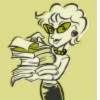 Jacques, Brian. Christopher Denise. (Ill.) 1996. THE GREAT REDWALL FEAST. New York: Puffin Books. ISBN 0-329-21714-3
Jacques, Brian. Christopher Denise. (Ill.) 1996. THE GREAT REDWALL FEAST. New York: Puffin Books. ISBN 0-329-21714-3Of the fifteen plus Redwall books, this one is atypically light-hearted. Written in rhyming prose, Brian Jacques tells a story of abbeymice preparing a surprise feast for the abbot—also a mouse. Luckily for the residents of Redwall, the abbot goes on an unexpected, long walk. As it turns out, he knew all along about the surprise and was intentionally giving the devoted abbeymice an opportunity to prepare “in secret.” Though apparently occurring in medieval times, THE GREAT REDWALL FEAST has no specified era. The setting, the Redwall abbey, is most likely in a fantastic version of Britian. This may be supposed by the dialect reflected in the text, for example using “noice” for nice and “marm” for ma’am. Also, the illustrations show a great castle abbey in a countryside reminiscent of western Europe. The writing style makes this prose difficult to read aloud and tedious to read silently. The target audience, grades K-3 are not likely to have the patience to wade through this lengthy picture book. Older readers may be put off by the juvenile and merry tone of the illustrations and story.
While the illustrations in this story are geared for readers grades K-3, the prose is written at a much higher interest level.




